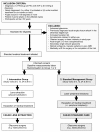The effectiveness of early lens extraction with intraocular lens implantation for the treatment of primary angle-closure glaucoma (EAGLE): study protocol for a randomized controlled trial
- PMID: 21605352
- PMCID: PMC3121608
- DOI: 10.1186/1745-6215-12-133
The effectiveness of early lens extraction with intraocular lens implantation for the treatment of primary angle-closure glaucoma (EAGLE): study protocol for a randomized controlled trial
Abstract
Background: Glaucoma is the leading cause of irreversible blindness. Although primary open-angle glaucoma is more common, primary angle-closure glaucoma (PACG) is more likely to result in irreversible blindness. By 2020, 5·3 million people worldwide will be blind because of PACG. The current standard care for PACG is a stepped approach of a combination of laser iridotomy surgery (to open the drainage angle) and medical treatment (to reduce intraocular pressure). If these treatments fail, glaucoma surgery (eg, trabeculectomy) is indicated. It has been proposed that, because the lens of the eye plays a major role in the mechanisms leading to PACG, early clear lens extraction will improve glaucoma control by opening the drainage angle. This procedure might reduce the need for drugs and glaucoma surgery, maintain good visual acuity, and improve quality of life compared with standard care.EAGLE aims to evaluate whether early lens extraction improves patient-reported, clinical outcomes, and cost-effectiveness, compared with standard care.
Methods/design: EAGLE is a multicentre pragmatic randomized trial. All people presenting to the recruitment centres in the UK and east Asia with newly diagnosed PACG and who are at least 50 years old are eligible.The primary outcomes are EQ-5D, intraocular pressure, and incremental cost per quality adjusted life year (QALY) gained. Other outcomes are: vision and glaucoma-specific patient-reported outcomes, visual acuity, visual field, angle closure, number of medications, additional surgery (e.g., trabeculectomy), costs to the health services and patients, and adverse events.A single main analysis will be done at the end of the trial, after three years of follow-up. The analysis will be based on all participants as randomized (intention to treat). 400 participants (200 in each group) will be recruited, to have 90% power at 5% significance level to detect a difference in EQ-5D score between the two groups of 0·05, and a mean difference in intraocular pressure of 1·75 mm Hg. The study will have 80% power to detect a difference of 15% in the glaucoma surgery rate.
Trial registration: ISRCTN44464607.
References
Publication types
MeSH terms
Substances
Associated data
Grants and funding
LinkOut - more resources
Full Text Sources


